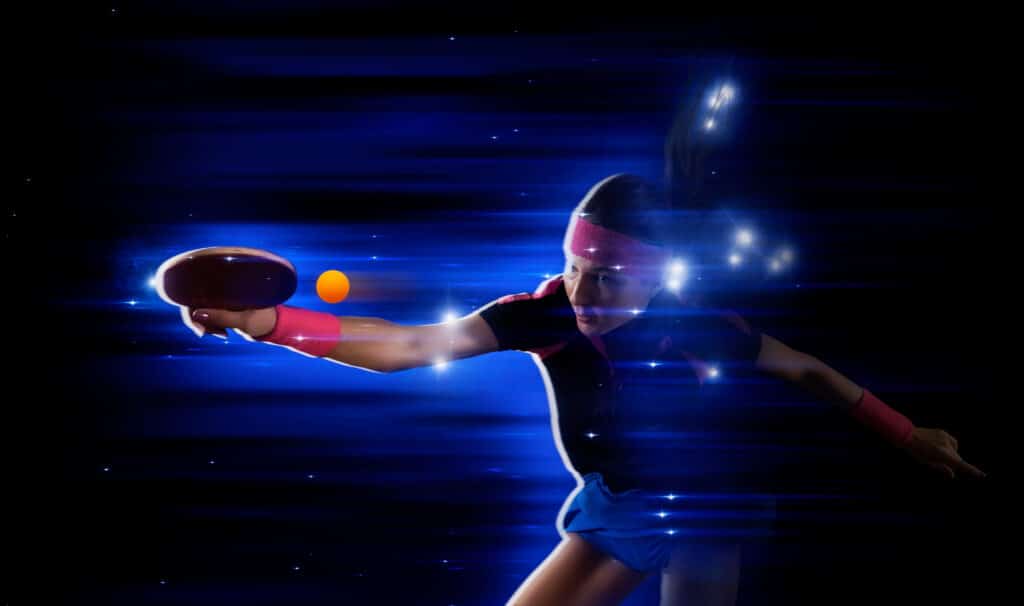How science can improve sporting performance
- Researchers are studying table tennis to understand the techniques involved in the game and improve player performance, particularly in the run-up to the 2024 Olympic Games.
- They use an algorithm to analyse videos of matches and then represent rallies in the form of a graph.
- In this way, they can characterise the position of the players, the way they move when they hit a ball, and the movement and trajectory of the ball.
- Unlike other sports, table tennis is very synchronous, which means that stroke sequences are strongly correlated with player behaviour.
- The analyses from this study will enable players adjust their game relative to their opponents and improve their own strategies.
Table tennis, a popular racket sport, has been an Olympic discipline since 1988. It is also a subject for academic study in which university researchers analyse the patterns and tactics in the game to improve players’ competitive performance. Researchers at the École Centrale Lyon’s Laboratoire d’informatique en images et systèmes d’information (LIRIS UMR 5205 CNRS) are working in close collaboration with the French Table Tennis Federation (FFTT), the body responsible for managing table tennis in France and providing technical support to the highest-level players. The scientists are analysing videos of matches available on broadcasting platforms online and attempting to identify patterns of play based on datasets containing relatively short (four to five strokes on average) but complex (some twenty descriptors per stroke) sequences of racket strokes. They have their work cut out in the run-up to this summer’s 2024 Olympic Games in Paris.
In a table tennis match, players take turns hitting the ball with their racket and bouncing it off the opponent’s side of the table – except when serving, when the ball must bounce off both sides. A rally is lost if a player fails to return the ball in accordance with these rules. A player wins a set when 11 points or more are reached, with a difference of two points between the opponents.
Analysing winning stroke combinations
In their work, the researchers led by Romain Vuillemot, analyse the position of the players, the way they move during a stroke, and the movement and trajectory of the ball. The scientists are focusing on analysing winning stroke combinations to characterise player tactics. According to FFTT coaches, a tactic consists of two consecutive strokes for one of the players, which means that in a rally, it is played in three consecutive strokes for both players. The serving player controls the first two strokes of the game, then hits the ball back to the opponent in a way to potentially win the point. Exchanges beyond the first three strokes are interesting technically and can take precedence over tactics.
Finding useful tactics in this way is not limited to table tennis competitions but can also be applied to other sports such as football and boxing, even though these involve much more physical contact between players. In football, however, a sequence is defined as a list of several consecutive moves made by the same player or moves by different players at the same time. In a table tennis match, the sequences are actually a rally (and therefore highly synchronous). Thus, in a series of consecutive table tennis shots, the two players appear alternately in a sequence. This means that there is a strong correspondence between the sequence of strokes and the player, with actions/reactions, anticipations, and dominations.
The researchers analysed the sequence of strokes in a rally until it was won by one of the two players. A sequence has the following structure:
- A serve (from the right or left side) that hits one of the nine possible impact zones on the opponent’s side of the table.
- A sequence of strokes described by the type of stroke (control, attack, or push), whether it is a backhand or forehand stroke and the impact zone of the ball.
Other descriptors are also analysed, such as spin, technique, and player position.
A tailor-made algorithm
Using a new algorithm that they developed in their laboratory, the researchers constructed a graph representing a set of rallies based on visual data from a video. The nodes of the graph represent the moves, and its edges represent the transitions between moves. The nodes are ordered so that rallies are “read” from left to right: the leftmost node is the serve, and the rightmost node is the winner of the rally.
“By analysing the movements of each player, the movements of the racket and the trajectories of the ball on the table, we can classify the type of stroke into different categories and analyse what happens during each point,” explains Romain Vuillemot. “We then try to understand the strategy behind a given stroke. To do this, we need to understand what the player is doing in general and how his opponent is reacting, that is, has he adapted to his competitor’s game? This is a very complex task, but our graphs already allow us to identify potentially effective sequences. We then need to contextualise these results, particularly in terms of the score or the dominance of one of the players”. Tactically interesting points are often few and far between, but they are often decisive in explaining a victory.
How to adopt a winning strategy?
The results of the analyses will provide players, and their coaches, with the information they need to understand and adapt to the game of their opponents, and thus improve their own strategies.

“What we have found is that the tactics adopted depend on each player and their style of play,” explains Aymeric Erades, a doctoral student working on the project with Romain Vuillemot. “What’s interesting is that a given player won’t always play in the same way. The idea is therefore to detect all the possible play combinations and then to understand the ones that will be used during the game, particularly against an opponent whose strengths, weaknesses, and general style of play we are familiar with.”
To date, the researchers have analysed around 30 matches in their entirety and are in the process of analysing a further 70. “This number could increase in the run up to the Olympic Games this summer since table tennis players are busy getting ready for their matches and coaches are asking us to provide them with additional data on new opponents,” explains Aymeric Erades.
“Between now and the summer, we hope to have obtained tactical analyses of all the potential opponents that the French team is likely to encounter to understand how they play and ultimately communicate this information to the federation so that our players have the best chances of beating their opponents,” adds Romain Vuillemot.
Isabelle Dumé
References:
Exploring Table Tennis Analytics: Domination, Expected Score and Shot Diversity. Machine Learning and Data Mining for Sports Analytics workshop MLSA, 2023
Visual Analysis of Table Tennis Game Tactics. Journée Visu 2023, 22 juin 2023, Saclay (France)
Pierre Duluard, Xinqing Li, Marc Plantevit, Céline Robardet, Romain Vuillemot. Discovering and Visualizing Tactics in a Table Tennis Game Based on Subgroup Discovery. ECML/PKDD 2022 Workshop, Grenoble, France, 2022. hal-03768114















